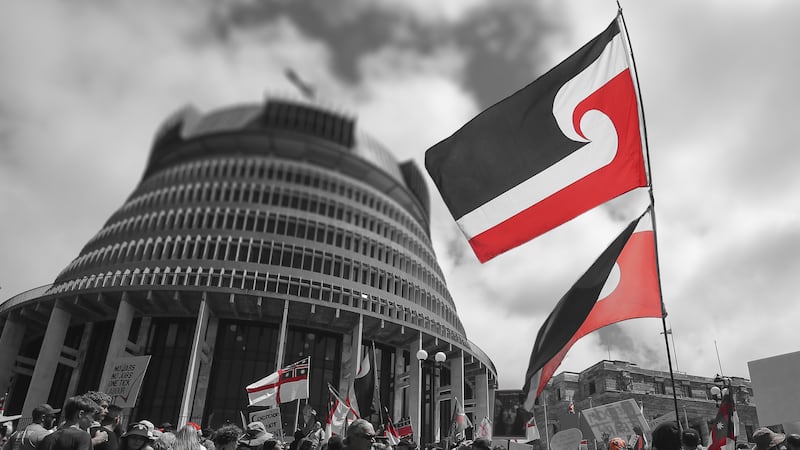After 20 years, Blackfoot leader returns to Aotearoa, reconnecting with whānau and continuing the fight to protect Indigenous language and culture.
Manyfeathers, of the Blackfoot Confederacy and Kainai Nation, first came to Aotearoa as a rangatahi for the World Indigenous Peoples’ Conference on Education at Waikato. This year, she returned as a rangatira, one of the educators and leaders working to revitalise Indigenous languages.
When Manyfeathers’ feet touched the ground in Aotearoa, she felt the connection to her whānau at the marae where she had been welcomed as a rangatahi. She was gifted, nurtured, and treated like a relative, and remembers calling the wāhine there “`whāea.”
“When I landed, I was being called Whāea, and that is something I will remember forever. It is a huge blessing for me, and I want to be the Whāea for the young people of this land, and I will honour that role.”

Political pushback and breaches of Te Tiriti
“As Blackfoot people, we were looking 20 years ago, and still look towards the Māori as almost the leaders in this work of language reclamation and revitalisation,” she reflected.
Manyfeathers said she was saddened to see the coalition government remove and reduce the use of te reo Māori, and felt the country had shifted backwards since she first visited two decades ago.
“Coming back twenty years later, the Māori people are still honouring the Treaty, but the other side is not honouring that Treaty,” she remarked.
“By taking the language away, you’re actually taking away the spirit of the people. And these are the people who allowed them to come here. You have a sacred agreement, and this really shows their philosophy as colonisers.”
We might be an ocean apart, but we are united by that fire within us that and that resilience. They were trying to kill us off, but because we’re so strong and we’re so powerful, we’re not gonna die. And we’re not gonna take this lying on our backs.
— Sandra Manyfeathers, Blackfoot Educator
The Blackfoot people signed a treaty with the British Crown in September 1877. Similar to Māori, there was both a language barrier and a clash of philosophies.
“We signed a peace Treaty; we did not sign a land surrender,” she explained.
However, Europeans interpreted it as a legal document that ceded the land.
“We are the land, the water, the mountains, the cosmos. We can’t disconnect ourselves from ourselves. There isn’t even language for that kind of philosophy,” she said.
Reclaiming language and culture after generations of residential schools
Once the Treaty was signed, Indigenous children were taken from their families and forced into residential schools. While most of these schools closed by the mid-1970s, the last one did not close until the late 1990s.
The goal was to assimilate and Christianise Indigenous children by removing them from their parents, culture, and community. Children were often called “savages,” forbidden from speaking their languages or practicing their traditions, and some never returned home, with reports in recent years of hundreds of unmarked graves across Canada. Survivors recount physical, sexual, and emotional abuse.

Manyfeathers explained that once children were released from residential schools, they had lost their languages and didn’t understand their cultures, leaving them to repair the damage and reintegrate into their communities.
“They tried to kill us on our own land, but they were not successful, and now that they have not killed us, we are coming back to the way Creator intended us to be living, on our own land, and our communities are doing this because of our own resilience,” she said.
“It was a monumental waste of time because we are resilient. Our strength and our power come from the land itself and from the cosmos.”
Regaining lost language
As a child, Manyfeathers’ mother and father spoke Blackfoot fluently.
“The language was alive in our home, continuously, and it was something we may have taken for granted as children,” she said.

Still a child, she left the reserve and lived in the city for about 30 years. When her eldest brother visited he noticed she was losing the language and helped to revitalise it.
“As a result of his commitment to me, I regained the ability to speak.
The power, spirit and philosophy of Indigenous languages
Manyfeathers said she discovered the language was a powerful spirit of goodness and kindness, carrying medicine she hadn’t expected.
“If you are open to it, and you embrace it, it will bless you and nourish you in a way that is profound,” she expressed.
“The English language is very much a language about money. And money is not real; it’s an agreed-upon philosophy. My language is rooted in sweetgrass; it is the language of the earth and the cosmos,” she explained.
“You can’t achieve that by speaking in the language of the coloniser. When you engage in Indigenous languages, you’re engaging in a philosophy that is meant to nourish your body, fill you with the medicine that has the power to heal the world itself.”
Passing knowledge onto the next generation
“Being able to embody the language and being able to think with a Blackfoot mind has inspired me to give that to the younger generation now.”
Manyfeathers has completed her doctorate and created a pathway for the next generation’s language to flourish.
“That’s what my life work is about, giving that medicine back to the people.”


